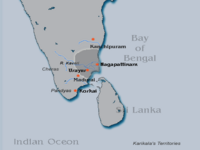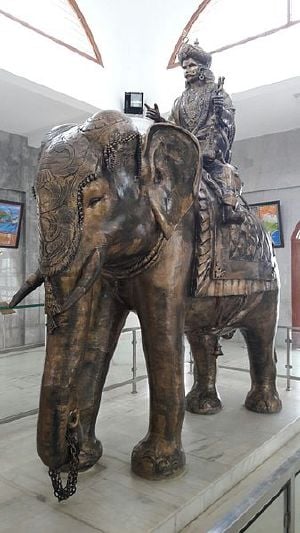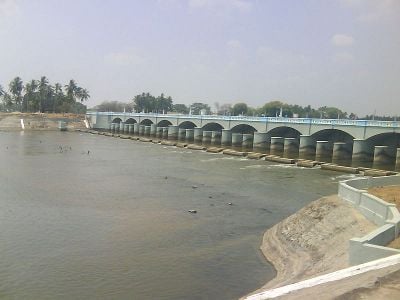Karikala Chola
Karikala Chola (Tamil: கரிகால சோழன்), the greatest among the early Chola kings of the Sangam age in South India, was the son of Ilamcetcenni and ruled around 120 C.E. His name means "the man with the charred leg," an injury he received during a fight to escape capture from a scheming competitor for his throne. He was known by the epithets Karikala Peruvallattan (கரிகால பெருவளத்தான்) and Thirumavalavan (திருமாவளவன்). Karikala led the Chola empire successfully in campaigns to unify the three Dravidian kingdoms. In the Battle of Venni, Karikala crushed the Pandya and Chera forces, leading to the unifying of the three kingdoms into one under Karikala's rule. He also earned praise for the beauty of his war chariots.
Karikala's Chola garnered great wealth in trade with the Roman empire. He used that wealth to fund his military campaigns and to build his cities. He is reputed to have decorated the capital city of Kanchipuram with gold. He earned lasting fame by building dikes along the banks of Kaveri. He built the Grand Anaicut, the oldest dam in the world, and irrigation canals as well as tanks. His innovations and projects with irrigation greatly aiding agriculture in his kingdom.[1] He left a legacy as an able and just king, promoting commerce and administering justice. He appears to have been sincerely mourned by the people of Chola at his death.
| ||||||||||||||||||||||||||||||||||||||||||||||
| ||||||||||||||||||||||||||||||||||||||||||||||
| ||||||||||||||||||||||||||||||||||||||||||||||
Sources
The story of Karikala mixes legend and anecdotal information gleaned from Sangam literature. Karikala has left history no authentic records of his reign. The numerous mentions in Sangam poetry constituted the only sources available to us. The extant literature of the Sangam has been difficult to date with any measure of certainty, leaving the time period in question.
Pattinappaalai,[2] Porunaraatruppadai,[3] and a number of individual poems in Akananuru[4] and Purananuru[5] have been the main source for the information attributed to Karikala.
Early life
Karikala, the son of Ilamcetcenni, had been distinguished for the beauty of his numerous war chariots. The name Karikalan means "the man with the charred leg" and perpetuates the memory of a fire accident in the early years of his life. Porunaraatruppadai describes the legend of that incident as follows:
The king of Urayur Ilancetcenni married a Velir princess from Azhundur and she became pregnant and gave birth to Karikala. Ilamcetcenni died soon after. Due to his young age, Karikala's right to the throne was overlooked and there was political turmoil in the country. Karikala was exiled. When normality returned, the Chola ministers sent a state elephant to look for the prince. The elephant found the prince hiding in Karuvur. His political opponents arrested and imprisoned him. The prison was set on fire that night. Karikala escaped the fire and, with the help of his uncle Irumpitarthalaiyan, defeated his enemies. Karikala’s leg was scorched in the fire and from thence Karikala became his name.[3]
Pattinappaalai, written in praise of Karikala, also describes the incident:
Like the Tiger cub with its sharp claws and its curved stripes growing (strong) within the cage, his strength came to maturity (like wood in grain) while he was in the bondage of his enemies. As the large trunked elephant pulls down the banks of the pit, and joins its mate, even so after deep and careful consideration, he drew his sword, effected his escape by overpowering the strong guard and attained his glorious heritage in due course.[3]
Military conquests
Battle of Venni
According to Porunaraatruppadai, Karikala Chola fought a great battle at Venni near Thanjavur in which both Pandya and Chera suffered crushing defeats. Although very little is known about the circumstances leading to that battle, it marked the turning point in Karikala’s career, the battle breaking the back of the powerful confederacy formed against him. Besides the two crowned kings of the Pandya and Chera countries, eleven minor chieftains took their side in the campaign and shared defeat at the hands of Karikala. The Chera king, wounded on his back in the battle, committed suicide by starvation.
Venni proved the watershed in the career of Karikala, which established him firmly on his throne and secured for him a virtual hegemony among the three crowned monarchs.
Other wars and conquests
After the battle of Venni, Karikala had other opportunities to exercise his arms. He defeated the confederacy of nine minor chieftains in the battle of Vakaipparandalai. Paranar, a contemporary of Karikala, in his poem from Agananuru mentions that incident without giving any information on the cause of the conflict.
Pattinappaalai also describes the destruction caused by Karikala’s armies in the territories of his enemies and adds that as the result of those conflicts, the "Northerners and Westerners were depressed… and his flushed look of anger caused the Pandya’s strength gave way…."[3] Evidence showing that Karikala’s conquests extended beyond the land of the Kaveri has been missing.
Legends
Northern conquests
Since ancient times Karikala became the subject of many myths, which in modern times have often been accepted as serious history. Cilappatikaram (c. 300–900 C.E., probably sixth century C.E.) which attributes northern campaigns and conquests to all the three monarchs of the Tamil country, gives a glorious account of the northern expeditions of Karikala, which took him as far north as the Himalayas and gained for him the alliance and subjugation of the kings of Vajra, Magadha and Avanti countries. No contemporary evidence, either in Sangam literature or from the north Indian source, supports such an expedition taking place.
Raising the banks of Kaveri
Later Chola kings referred to Karikala Chola as a great ancestor, and attributed him with the building of dikes along the banks of the Kaveri. The raising of the banks of the river Kaveri by Karikala seems to be first mentioned by the Melapadu plates of Punyakumara, a Telugu Choda king of the seventh or the eighth century C.E.
That story mingles with another stream of legend centering around Trinetra Pallava, and culminates in the celebrated jingle of the late Telugu Choda inscriptions: Karuna—saroruha vihita—vilochana—pallava—trilochana pramukha kilapritvisvara karita kaveri tira ("He who caused the banks of the Kaveri to be constructed by all the subordinate kings led by the Pallava Trinetra whose third eye was blinded by his lotus foot.")[6]
Personal life and death
|
இறந்தோன் அவனே! அருப்பம் பேணாது அமர்கடந் ததூஉம்; |
Pattinappaalai describes Karikala as an able and just king. It gives a vivid idea of the state of industry and commerce under Karikala who promoted agriculture and added to the prosperity of his country by reclamation and settlement of forest land. He also built the Grand Anaicut, one of the oldest dams in the world and also a number of irrigation canals and tanks.
We know next to nothing regarding Karikala’s personal life. Naccinarkkiniyar, the annotator of Tolkappiyam, states that Karikala married a Velir girl from Nangur. He most certainly had more than one queen. Evidence exists in Purananuru for Karikala’s faith in the then embryonic Vedic Hinduism in the Tamil country. Purananuru (poem 224) movingly expresses his faith and the grief caused by his passing away:
- He who stormed his enemies' forts undauntedly, who feasted his minstrels and their families and treated them to endless draughts of toddy, who in the assembly of Brahmins noted for their knowledge of Dharma and purity of life, guided by priests learned in their duties and attended by his noble and virtuous queen, performed the vedic sacrifice in which the tall sacrificial post stood on a bird-like platform, within the sacrificial court surrounded by a high wall with round bastions, he, the great and wise king alas, is no more! Poor indeed is this world, which has lost him. Like the branches of the vengi tree, which stands bare, when their bright foliage has been stripped down by shepherds eager to feed their cattle in the fierce summer, are his fair queens, who have cast off their jewels.[3]
Notes
- ↑ Hermann Kulke and Dietmar Rothermund, A History of India (New York: Routledge, 2004. ISBN 04153292055).
- ↑ R.S. Vedachalam, A Critical Commentary on Pattinappalai (Pathipikkappattan).
- ↑ 3.0 3.1 3.2 3.3 3.4 Institute of Asian Studies, Encyclopedia of Tamil Literature (South Asia Books, 1990, ISBN 978-9991470689).
- ↑ C.E. Ramachandran, Ahananuru in its Historical Setting (Madras: University of Madras, 1974).
- ↑ George L. Hart and Hank Heifetz (eds.), The Four Hundred Songs of War and Wisdom: An Anthology of Poems from Classical Tamil: The Purananuru. (New York: Columbia University Press, 1999. ISBN 9780231115629).
- ↑ Eugen Hultzsch, South Indian Inscriptions (Hanse Bbooks, 2020 (original 1890), ISBN 978-3337952303).
ReferencesISBN links support NWE through referral fees
- Hart, George L., and Hank Heifetz (eds.). The Four Hundred Songs of War and Wisdom: An Anthology of Poems from Classical Tamil: The Purananuru. New York: Columbia University Press, 1999. ISBN 9780231115629
- Hultzsch, Eugen. South Indian Inscriptions. Hanse Bbooks, 2020 (original 1890). ISBN 978-3337952303
- Institute of Asian Studies. Encyclopedia of Tamil Literature. South Asia Books, 1990. ISBN 978-9991470689
- Kulke, Hermann, and Dietmar Rothermund. A History of India. New York: Routledge, 2004. ISBN 0415329205
- Majumdar, R.C. Ancient India. India: Motilal Banarsidass, 2007. ISBN 978-8120804364
- Ramachandran, C.E. Ahananuru in its Historical Setting. Madras: University of Madras, 1974.
- Sastri, K.A. Nilakanta. A History of South India From Prehistoric Times to the Fall of Vijayanagar. Oxford University Press, 1997. ISBN 978-0195606867
- Tripathi, Rama Shankar. History of Ancient India. Delhi: Motilal Banarsidass, 2018. ISBN 8120800184
- Vedachalam, R.S. A Critical Commentary on Pattinappalai. Pathipikkappattan, 1906.
External Links
All links retrieved July 24, 2023.
- Chola Dynasty (300 B.C.E.- 1250 C.E.) The Antique Story.
- Date of Karikal Chola Controversies in History.
- Searching for traces of the ancient Chola dynasty National Geographic.
Credits
New World Encyclopedia writers and editors rewrote and completed the Wikipedia article in accordance with New World Encyclopedia standards. This article abides by terms of the Creative Commons CC-by-sa 3.0 License (CC-by-sa), which may be used and disseminated with proper attribution. Credit is due under the terms of this license that can reference both the New World Encyclopedia contributors and the selfless volunteer contributors of the Wikimedia Foundation. To cite this article click here for a list of acceptable citing formats.The history of earlier contributions by wikipedians is accessible to researchers here:
The history of this article since it was imported to New World Encyclopedia:
Note: Some restrictions may apply to use of individual images which are separately licensed.


